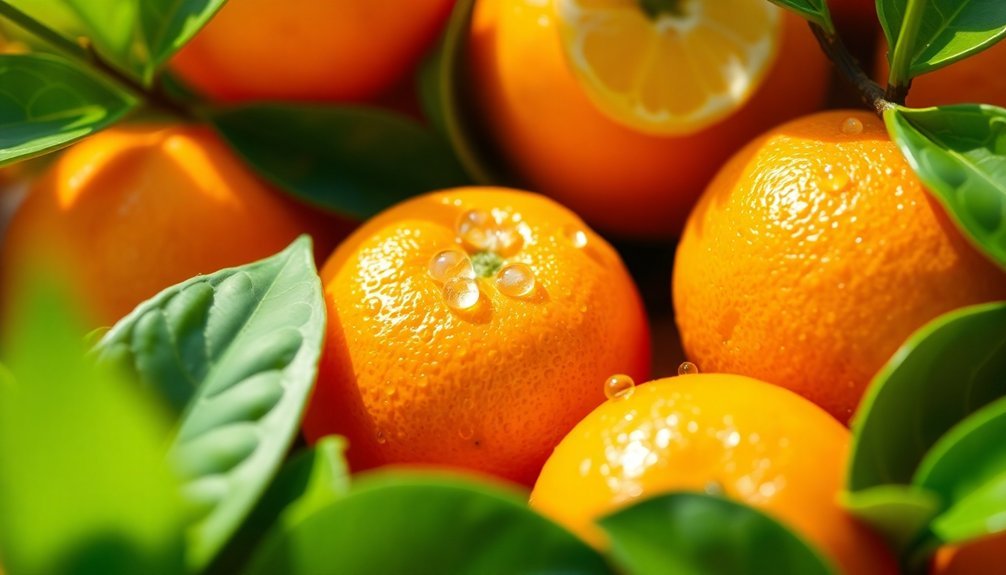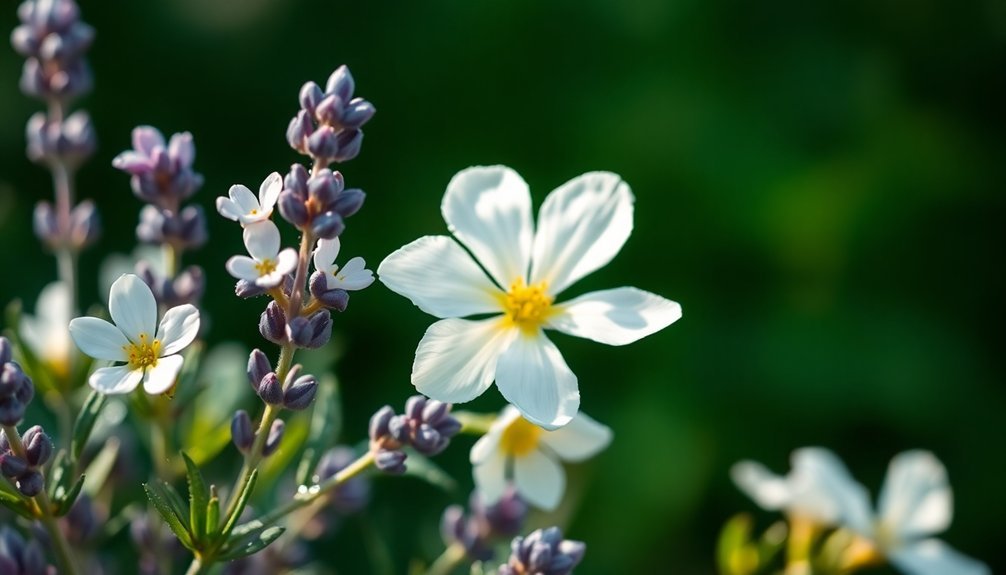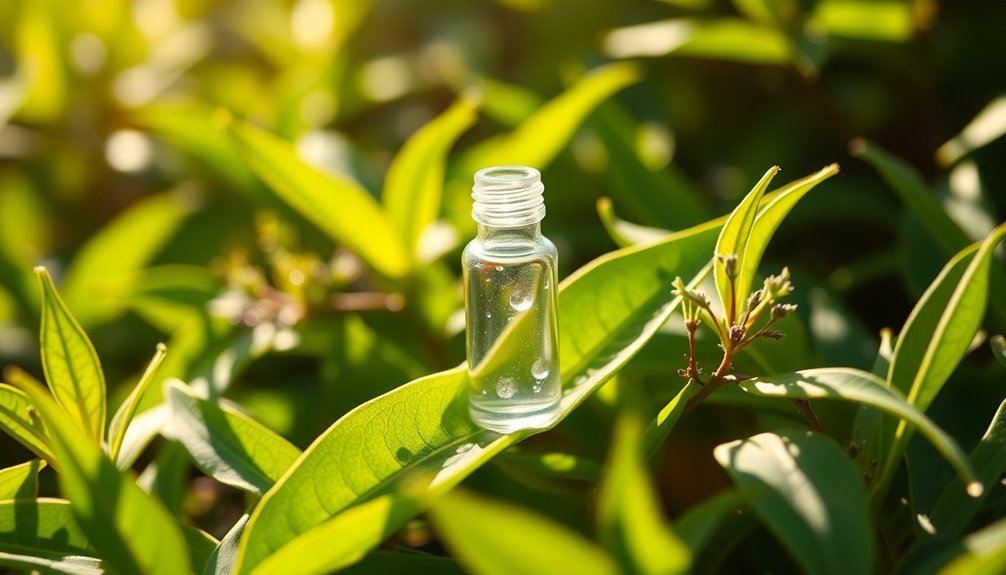Seven essential top notes will elevate your perfume-making from basic to professional. Start with bright citrus (bergamot, sweet orange), fresh herbs (peppermint, basil), and light florals (lavender, neroli). Add crisp fruits (apple, pear) and invigorating spices (ginger, cardamom) for complexity. Include green notes (petitgrain, green tea) and aromatics (eucalyptus, pine) to round out your palette. These versatile ingredients open the door to countless fragrance possibilities.
Bright Citrus Notes: Bergamot and Sweet Orange

Citrus notes form the cornerstone of many modern fragrances, with bergamot and sweet orange leading the way as two of perfumery's most cherished top notes.
You'll find bergamot's fresh, slightly bitter character adds sophisticated brightness to your fragrance profile, while sweet orange brings a juicy, uplifting quality that instantly evokes cheerfulness.
As you begin your perfumery journey, you'll appreciate the versatility of these bright citrus notes. They're excellent choices for creating that vital first impression, though keep in mind they'll evaporate within 5-15 minutes of application.
You can combine bergamot with petitgrain and neroli for added complexity, while sweet orange works beautifully to balance more intense notes.
Both options offer you reliable starting points for crafting vibrant, energetic fragrances that'll captivate your audience.
Fresh Herbal Notes: Peppermint and Basil
When you're ready to explore herbal top notes, you'll find peppermint's cool and energizing properties create an immediate invigorating impact in your fragrance compositions.
Peppermint's versatility shines as it pairs beautifully with citrus and floral notes, making it an excellent choice for your experimental blends.
Basil's sweet and spicy aromatic intensity adds a sophisticated layer to your creations while maintaining the fresh, natural character that modern fragrance enthusiasts seek.
Refreshing Mint Properties
The world of fresh herbal notes opens up exciting possibilities with peppermint and basil as top notes in perfumery. When you're working with peppermint, you'll discover its revitalizing scent creates an invigorating and cooling effect that immediately awakens the senses.
You'll find this herbal note particularly effective in summer fragrances, where it adds a burst of cleanliness and energy. To enhance your fragrance's depth and complexity, consider pairing peppermint with basil.
The combination delivers a dynamic blend of cool mint and warm, peppery undertones that'll energize your composition. These top notes work together to create an uplifting experience that's perfect for warm-weather scents.
You'll notice how these herbal notes complement each other while maintaining their distinct characteristics, offering a sophisticated approach to fresh, aromatic perfumery.
Basil's Aromatic Intensity
Powerful and distinctive, basil's aromatic profile brings a unique complexity to your fragrance compositions. You'll find its fresh, herbal notes create vibrant intensity that's perfect for crafting uplifting scents.
When you combine basil with peppermint, you'll achieve an invigorating blend that balances sweet, peppery undertones with sharp, minty freshness. As top notes, this herbal duo delivers an energizing opening that lasts 5-15 minutes before shifting to middle notes.
You'll notice basil's versatility when creating lively fragrances, as it appeals to those seeking dynamic, revitalizing scents. When working with these aromatics, remember that basil's natural sweetness complements peppermint's cooling properties, resulting in a well-rounded, sophisticated opening that captures attention and sets the tone for your entire composition.
Light Floral Notes: Lavender and Neroli

When you're starting with aromatic blending, lavender and neroli provide an ideal entry point as their light, fresh qualities allow for seamless combinations with various floral and citrus notes.
You'll find these ingredients create an enchanting spring garden effect, with lavender offering nostalgic freshness and neroli contributing sweet, verdant undertones.
Their natural calming properties make them excellent choices for crafting therapeutic fragrances that appeal to a broad audience seeking both tranquility and sophistication.
Classic Aromatic Blending Techniques
Among the most beloved light floral notes in perfumery, lavender and neroli offer new perfumers an excellent introduction to classic aromatic blending. You'll find these versatile top notes create a harmonious light floral accord that's perfect for daytime wear and appeals to all genders.
When you're learning classic techniques, you'll appreciate how lavender's calming properties complement neroli's uplifting qualities derived from orange blossom. Together, they'll form a balanced fragrance profile that's both fresh and soothing.
As you experiment with aromatic blending, you'll discover these notes pair beautifully with various middle and base notes, allowing you to create sophisticated compositions. The combination provides an ideal starting point for mastering traditional perfumery methods while developing your unique style in fragrance creation.
Fresh Spring Garden Notes
Spring gardens burst to life with the enchanting duo of lavender and neroli, creating an ethereal top note combination that captures nature's renewal. You'll find these fresh floral notes deliver immediate impact in your fragrance compositions, offering a perfect balance of calming and uplifting qualities.
| Lavender Notes | Neroli Notes |
|---|---|
| Light & Airy | Sweet & Green |
| Herbal Fresh | Orange Blossom |
| Calming | Joyful |
| Universal Appeal | Bright & Clean |
When you're crafting spring fragrances, combine these versatile notes to create compositions that resonate across generations. Lavender's soothing properties complement neroli's invigorating character, resulting in balanced blends that evoke feelings of serenity and liveliness. These top notes work harmoniously to capture the essence of a spring garden in full bloom.
Calming Therapeutic Properties
Beyond their enchanting garden aromas, lavender and neroli offer powerful therapeutic benefits that make them ideal choices for wellness-focused perfume creation.
As you explore these calming top notes, you'll discover why they're essential for crafting tranquil fragrances.
You'll find that lavender's aroma naturally reduces heart rates and stress levels, making it perfect for relaxation-centered perfumes. Its soothing properties are scientifically proven to improve sleep quality and decrease anxiety.
Similarly, neroli's sweet, fresh scent enhances emotional well-being while promoting a sense of peace.
When you're developing therapeutic fragrances, combining these two powerhouse ingredients can create a harmonious blend that addresses both mental and emotional balance.
Their light floral characteristics work together seamlessly, offering your perfume compositions both aromatic beauty and proven wellness benefits.
Crisp Fruit Notes: Apple and Pear

Fresh and invigorating, crisp fruit notes like apple and pear serve as crucial top notes in modern perfumery. You'll find these notes create an inviting and approachable first impression in your fragrance blend. While apple notes can range from sweet to tart, pear notes offer a softer, more elegant touch with their subtle floral undertones.
| Note Type | Characteristics | Best Paired With |
|---|---|---|
| Apple | Juicy, revitalizing, versatile | Citrus, mint |
| Pear | Soft, sweet, floral | White flowers, vanilla |
| Combined | Bright, clean, uplifting | Woods, musk |
When you're crafting your fragrance, consider pairing these crisp fruit notes with complementary elements to enhance their natural brightness. Their ability to evoke energy and cleanliness makes them perfect for creating modern, appealing scents that captivate from the first spritz.
Invigorating Spice Notes: Ginger and Cardamom
Zesty ginger and aromatic cardamom represent two of perfumery's most dynamic spice notes, offering both warmth and vibrancy to modern fragrance compositions.
You'll find these invigorating ingredients particularly effective when crafting fresh, energetic scents that stand out from the crowd.
Ginger brings a warm, spicy kick that instantly awakens the senses, while cardamom adds a sweet, complex depth that works beautifully with citrus and floral elements.
What makes these spice notes especially valuable is their versatility in unisex fragrances – they bridge traditional gender boundaries effortlessly.
When you're developing your perfume, you'll appreciate how these notes enhance both longevity and sillage, particularly when paired with amber or woody base notes.
They're equally suitable for daytime freshness or evening sophistication, making them essential tools in your perfumery palette.
Green Notes: Petitgrain and Green Tea

Moving from warming spices to cooler botanical elements, petitgrain and green tea notes bring an invigorating clarity to your fragrance compositions. These green notes offer versatility and freshness that'll enhance your perfume creations.
| Property | Petitgrain | Green Tea |
|---|---|---|
| Aroma | Woody-fresh | Crisp-clean |
| Effect | Vibrant | Soothing |
| Best Pairs | Citrus-floral | Floral-light |
When working with petitgrain, you'll discover how its fresh, slightly woody character derived from bitter orange leaves can elevate your blend's natural appeal. Green tea's clean, balanced profile creates a sense of tranquility that's perfect for daytime fragrances. Both ingredients work exceptionally well in unisex and feminine compositions, making them essential tools in your perfumery toolkit.
Aromatic Notes: Eucalyptus and Pine
When exploring aromatic top notes, eucalyptus and pine stand as powerful allies in creating memorable fragrances.
You'll find these natural elements offer distinct characteristics that can elevate your scent profile. Eucalyptus brings a fresh, invigorating quality that's known to promote clarity and relaxation, while pine contributes warm, woody undertones that ground your fragrance in nature's essence.
As top notes, both eucalyptus and pine will make their impact in the essential first 5-15 minutes of your fragrance.
When you combine these aromatic elements, you'll create an outdoor-inspired experience that appeals to those seeking a forest-like ambiance.
The duo works particularly well in both men's and women's perfumes, offering versatility while maintaining their distinctive fresh and woody characteristics.
Frequently Asked Questions
What Are the Most Popular Top Notes for Perfume?
You'll find jasmine leading the way at 62% popularity, followed by musk at 48%. Other favorite top notes include bergamot, orange, and patchouli, which add fresh and vibrant qualities to fragrances.
What Is the Best Note in Perfume?
You'll find jasmine is widely considered the best perfume note, as it's present in 62% of beloved fragrances. It's versatile, timeless, and creates an enchanting first impression that blends beautifully with other notes.
What Perfume Notes Are Attractive?
You'll find jasmine, musk, and vanilla are highly attractive perfume notes. They're universally appealing, with jasmine in 62% of popular scents, musk in 48%, and vanilla in 46% of beloved fragrances.
What Fragrance Notes Go Well Together?
You'll find that jasmine pairs beautifully with bergamot, while citrus notes complement rose perfectly. Try combining patchouli with vanilla, or mix spicy ginger with orange for an energizing blend that works wonderfully.
In Summary
When you're starting your perfumery journey, these seven categories of top notes offer the perfect foundation for creating memorable fragrances. They're versatile, widely available, and relatively easy to work with. Whether you choose zesty citrus, fresh herbs, or aromatic woods, you'll find these notes blend beautifully with middle and base notes. Start experimenting with these classics, and you'll be crafting unique scents in no time.





Leave a Reply